Solar Trees. You’d be forgiven for mistaking them for contemporary abstract works of art—after all, they are an aesthetic marvel. But these unique and striking structures offer more than meets the eye, harnessing the power of the sun to generate clean energy.
Solar Trees. You’d be forgiven for mistaking them for contemporary abstract works of art—after all, they are an aesthetic marvel. But these unique and striking structures offer more than meets the eye, harnessing the power of the sun to generate clean energy.
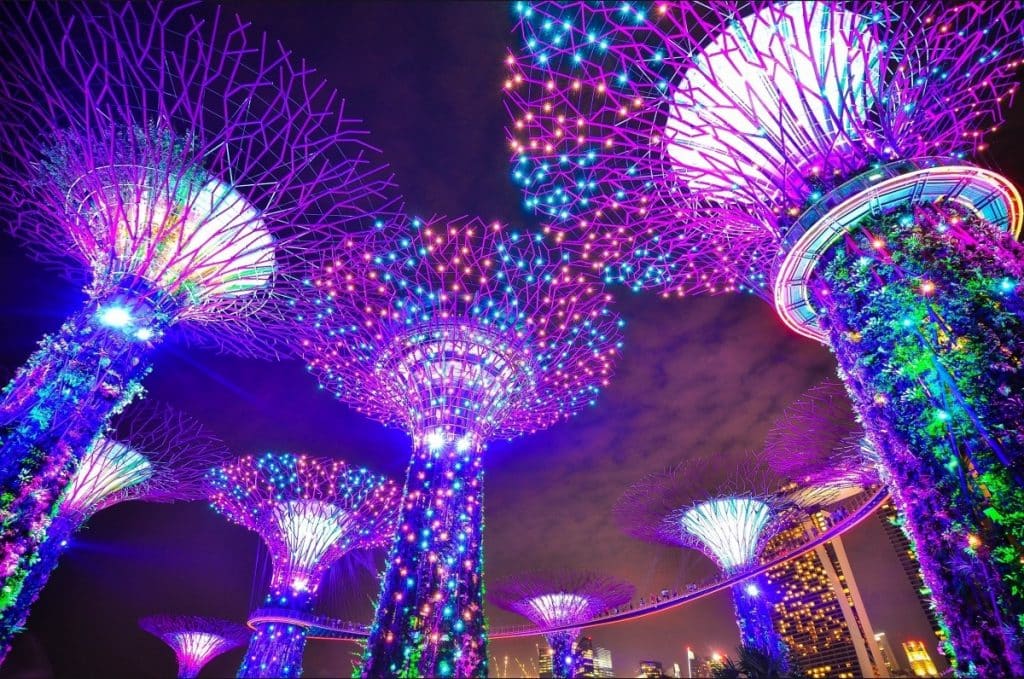
Unlike conventional house solar panels that are designed to blend in with their surroundings, solar trees are designed to be seen, creating awareness of solar technology and its potential to help reduce our reliance on fossil fuels.
In this article, we’ll explore what solar trees are, how they work and how they compare to conventional solar panels. We’ll also take a look at some notable examples of solar trees from Australia and around the world.
What are solar trees?
Solar trees are an innovative and attention-grabbing way of incorporating solar panels into the urban landscape. They use photovoltaic panels to convert sunlight into electrical energy. The name is derived from their appearance – many solar trees feature a branching structure reminiscent of a tree, with PV panels arrayed along the branches.
There is great diversity in the design of solar tree units, reflecting innovative responses to particular environments, climates and local energy needs.
Usually found located on sidewalks, parking lots or public meeting spaces, these sculptures capture sunlight through their canopy-like leaves, where it’s then converted into energy that can be used to power a wide variety of public utilities, such as street lamps and USB charging stations.
Solar trees are often used to promote sustainability and renewable energy initiatives, as well as to provide shade and improve the aesthetics of a city or town. They are not typically used as a primary source of energy for a property—they are instead complementary to rooftop solar systems, or other green building measures, symbolising these larger investments and their environmental benefit.
How do solar trees work?
Already inspired by botany, conventional solar panels imitate photosynthesising plants with their conversion of the sun’s light into usable energy. Solar panels use photovoltaic cells to absorb sunlight and convert it into electricity through a process known as the photoelectric effect, where light particles (photons) are absorbed by semiconducting materials such as silicon in order to release electrons which have been bound to the atoms in the material.
Solar trees work on a similar principle, but because of their unique design are far more efficient at capturing sunlight. Using a technique called spiralling phyllataxy, solar trees angle their panels in a spiralling fashion, allowing them to capture sunlight from all angles. Its calculated rotations allow even the lowermost solar panels to receive ample sunlight for electricity production.
The captured energy is typically conducted down through the trunk-like central pillar of the structure to an internal battery that stores energy generated for use at any time day or night.

What are the benefits of solar trees vs. conventional solar panels?
First and foremost, it’s important to remember that solar trees aren’t seeking to replace traditional solar panels – both technologies serve different purposes and have their place in a sustainable energy landscape. However, solar trees do have some unique benefits that make them an attractive option in certain situations:
- Small Footprint: In crowded urban landscapes where land is at a premium, solar trees take up minimal space and can be placed almost anywhere, whereas conventional solar panels require large, open areas like rooftops or fields.
- Aesthetics: While rooftop solar panels have improved in appearance over the years, they rarely qualify as an attractive addition to a building. Solar trees, on the other hand, can become landmarks and tourist attractions in their own right. They enhance the look and feel of public spaces, drawing attention to green initiatives while at the same time providing functional utilities such as charging stations for electronic devices or street lights.
- Efficiency: The amount of power that solar trees can produce varies depending on their size and design but, typically, their compact footprint as well as the unique way their panels are angled means that solar trees require significantly less space to produce the same amount of electricity as horizontal solar panels.
Fundamentally, solar trees are designed to supplement conventional solar energy systems. They can provide shade and an aesthetically pleasing focal point, while also generating electricity for local use.
Conventional solar panels are a more practical and cost-effective way to capture solar energy for the masses, but solar trees are the perfect solution for businesses and multiplicities that want to make a statement about their commitment to sustainability.
Examples of Solar Trees
There are several notable examples of solar trees around the world, mostly throughout Europe and Asia.
Singapore’s Garden by the Bay
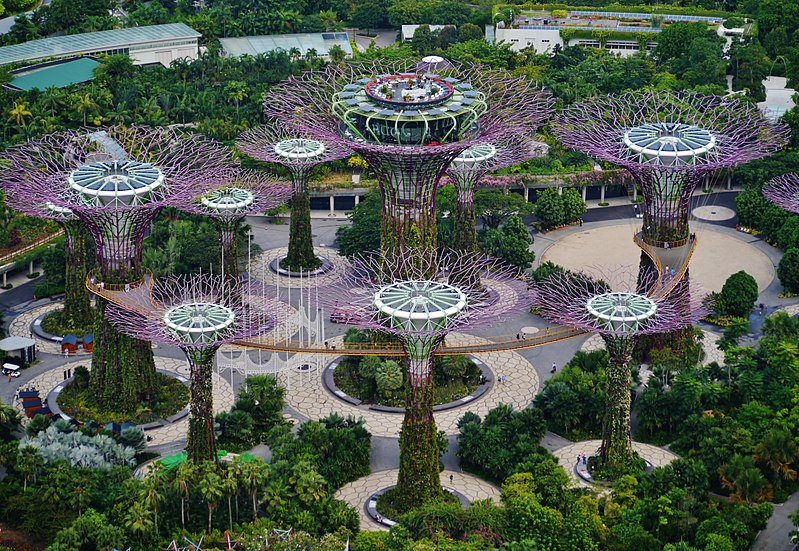
Arguably the most recognisable examples of solar trees in the world are the 25-50 metre high solar-powered “supertrees” at Singapore’s Garden by the Bay.
The man-made mechanical forest consists of 18 supertrees, featuring tropical flowers and various ferns climbing across their steel framework. The large canopies operate as temperature moderators, absorbing and dispersing heat, as well as providing shelter from the hot temperatures of Singapore’s climate to visitors walking beneath. At night, the supertrees are illuminated by a spectacular light show that can be seen for miles.
To generate electricity, 11 of these trees are fitted with solar photovoltaic systems which power lighting and aid water technology within the conservatories below.
Ross Lovegrove’s Solar Tree
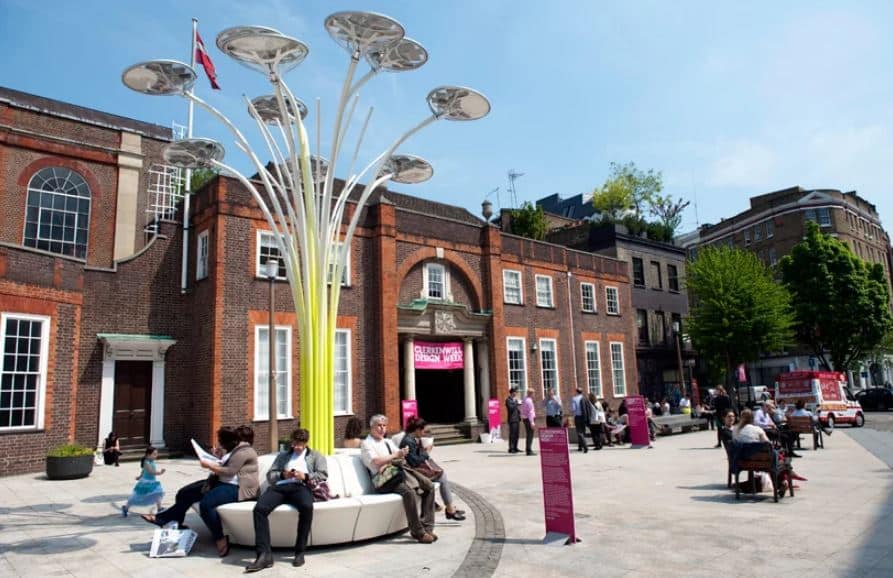
Another well-known example is the solar tree designed by renowned Welsh designer Ross Lovegrove in collaboration with Sharp Solar and Italian lighting brand Artemide. This unique structure was originally commissioned for the Museum for Angewandte Kunst (MAK) in Vienna, combining aesthetics and functionality into a beautiful visual display that doubles as an energy source. Lovegrove’s Solar Tree design has since been utilised in numerous locations, including London.
The Solar Tree is composed of 20 ‘stems’, leading to six leaf-like solar panels, four large lights, and 10 ‘grass stalks’, each also capped with an LED. The solar panels charge batteries during the day and at dusk the Solar Tree automatically switches on its LEDs. The internal control can also regulate the amount of light produced depending on how much charge is left in the batteries.
CSIR-CMERI Durgapur – The World’s Largest Solar Tree
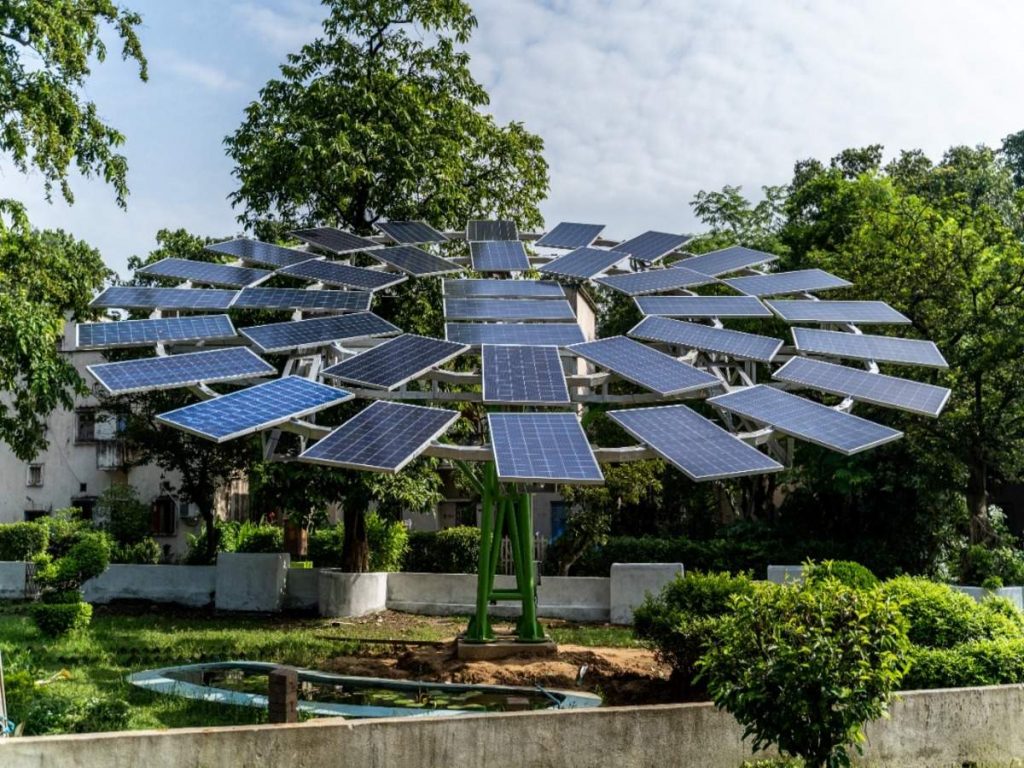
The Central Mechanical Engineering Research Institute, under the Council of Scientific and Industrial Research (CSIR-CMERI) in India, claimed to have developed and installed the world’s largest solar tree back in 2020.
The solar tree—installed at CSIR-CMERI Residential Colony in Durgapur—features a total of 35 solar PV panels each with a capacity of 330 Wp. The arms holding the solar panels are flexible and can be adjusted as per requirement, ensuring maximum exposure of each solar panel to sunlight while creating the least shadow area beneath.
Annually, it can generate 12,000-14,000 kWh of clean and green power.
Melbourne LeadSun Solar Tree
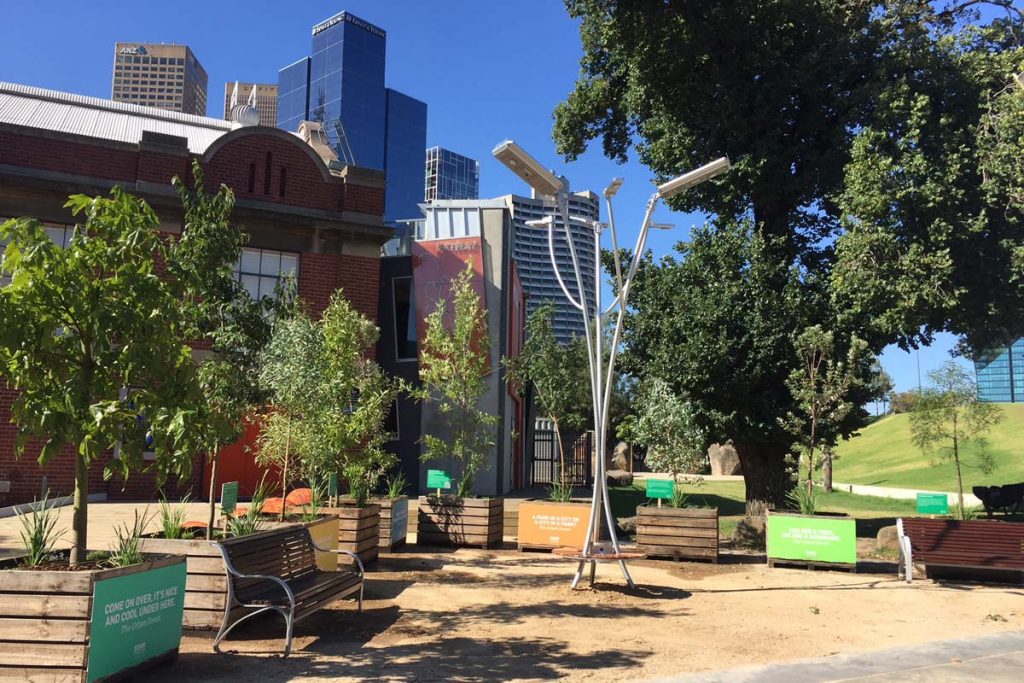
The City of Melbourne has its very own solar tree. Designed for the Sustainable Living Festival, the solar tree features a combination of three 80W ‘Solar-Engines’ that collects and captures energy from the sun, funnels it down a central tree trunk-like pillar into built-in Lithium-Ion batteries
The design features USB power charging sockets, LED lighting and a circular seat paneled with wood reclaimed from ageing trees in the municipality. The ultra-efficient LED lighting fixtures incorporate motion-sensor and dimming capabilities, providing a beacon of light throughout the evening for safety.
The solar tree was produced by solar manufacturers LeadSun who say, “This project was special to us as it symbolises the combination of modern technology and environmental sustainability.”

A Beacon of Inspiration
Whilst solar trees are both functional and beautiful, they primarily act as a physical reminder of our responsibility to the planet and the need for us to work together to find innovative ways of producing energy without harming the earth.
They are a beacon of inspiration, showing that it is possible for us to live in harmony with nature. We can all do our bit to reduce our reliance on fossil fuels and help create a cleaner, more sustainable future.
One of the most effective ways that you can reduce your carbon footprint is to make the switch to renewable energy. Installing rooftop solar panels not only saves you money on your energy bills, but also helps reduce the demand for dirty coal-fired power. A standard 6.6kw solar system will produce around 10,600 kwh a year which will save around 10.6 tonnes of CO2 emissions per year
Energy Matters has assisted over 30,000 Australians in their transition to clean energy. We can guide you toward solar and/or battery storage solution that fits your lifestyle and budget. Receive up to 3, obligation-free solar quotes from our trusted network of accredited solar installers. It’s fast, free, and takes the hassle out of shopping around.
Our professional solar installers in Melbourne will assess and determine your energy needs. We customise a solar panel system in Melbourne to fit the roof size of your properly, ensuring you receive the most suitable a solar panel system for your Melbourne home, meeting to property’s energy requirements.











































